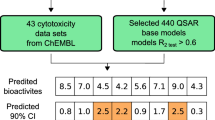Abstract
Estimation of bioavailability and toxicity at the very beginning of the drug development process is one of the big challenges in drug discovery. Most of the processes involved in ADME are driven by rather unspecific interactions between drugs and biological macromolecules. Within the past decade, drug transport pumps such as P-glycoprotein (Pgp) have gained increasing interest in the early ADME profiling process. Due to the high structural diversity of ligands of Pgp, traditional QSAR methods were only successful within analogous series of compounds. We used an approach based on similarity calculations to predict Pgp-inhibitory activity of a series of propafenone analogues. This SIBAR approach is based on selection of a highly diverse reference compound set and calculation of similarity values to these reference compounds. The similarity values (denoted as SIBAR descriptors) are then used for PLS analysis. Our results show, that for a set of 131 propafenone type compounds, models with good predictivity were obtained both in cross validation procedures and with a 31-compound external test set. Thus, these new descriptors might be a versatile tool for generation of predictive ADME models.
Similar content being viewed by others
References
Kaliszan, R., Kaliszan, A. and Wainer, I.W., J. Pharm. Biomed. Anal., 11 (1993) 505.
Kansy, M., Senner, F. and Gubernator, K., J. Med. Chem., 41 (1998) 1007.
Sadowski, J. and Kubinyi, H., J. Med. Chem., 41 (1998) 3325.
Wagener, M. and van Geerestein, V. J., J. Chem. Inf. Comput. Sci., 40 (2000) 280.
Ertl, P., Rohde, B. and Selzer, P., J. Med. Chem., 43 (2000) 3714.
Cruciani, G., Pastor, M. and Guba, W., Eur. J. Pharm. Sci., 11 (2000) Suppl 2 S29.
Kubinyi, H., Hamprecht, F.A. and Mietzner, T., J. Med. Chem., 41 (1998) 2553.
Good, A.C. Peterson, S.J. and Richards, W.G., J.Med. Chem., 36 (1993) 2929.
Benigni, R., Cotta-Ramusino, M., Giorgi, F. and Gallo, G., J. Med. Chem., 38 (1995) 629.
Ghuloum, A.M., Sage, C.R. and Jain, A.N., J. Med. Chem., 42 (1999) 1739.
Ayrton, A. and Morgan, P., Xenobiotica, 31 (2001) 469.
Gottesma,, M.M., Fojo, T. and Bates, S.E., Nature Rev. Cancer, 2 (2002) 48.
Teodori, E., Dei, S., Scapecchi, S. and Gualtieri, F., Farmaco, 57 (2002) 385.
Ecker, G.F. and Chiba, P., Recent Res. Devel. Medicinal Chem., 1 (2001) 121.
Schmid, D., Ecker, G., Richter, E., Hitzler, M. and Chiba, P., Biochem. Pharmacol., 58 (1999) 1447.
Chiba, P., Burghofer, S., Richter, E., Tell, B., Moser, A. and Ecker, G., J. Med. Chem., 38 (1995) 2789.
Ecker, G., Chiba, P., Hitzler, M., Schmid, D., Visser, K., Cordes, H.P., Csoellei, J., Seydel, J.K. and Schaper, K.J., J. Med. Chem., 39 (1996) 4767.
Salem, M., Richter, E., Hitzler, M., Chiba, P. and Ecker, G., Sci. Pharm., 66 (1998) 147.
Tmej, C., Chiba, P., Huber, M., Richter, E., Hitzler, M., Schaper, K.J. and Ecker, G., Arch. Pharm. Pharm. Med. Chem., 331 (1998) 233.
Ecker, G., Huber, M., Schmid, D. and Chiba, P., Mol. Pharmacol., 56 (1999) 791
SYBYL 6.7, Tripos Inc., Munich (Germany) 2001
Dewar, M.J.S., Zoebisch, E.G., Healy, E.F. and Stewart, J.J.P., J. Am. Chem. Soc., 107 (1985) 3902
SPECS and BioSPECS B.V., Rijswijk, The Netherlands, 2001; http://www.specs.net
UNITY 4.3, Tripos Inc., Munich (Germany) 2001
Hall, L.H. and Kier, L.B., In Lipkowitz, K.B. and Boyd, D.B., (eds.) Reviews in Computational Chemistry Vol. 2, VCH Publishers, New York, NY, 1992, pp. 367–422.
Kier, L.B. and Hall, L.H., J. Chem. Inf. Comput. Sci., 31 (1991) 76.
Balaban, A.T., Chem. Phys. Lett., 89 (1982) 399.
TSAR 3.3, Oxford Molecular Ltd., The Medware Center, Oxford Science Park, Oxford 2000.
van de Waterbeemd, H., Drugs Fut., 27/ Suppl. A (2002) 12 (L10)
Palm, K., Stenberg, P., Luthman, L., Artursson, P., Pharm. Res., 14 (1997) 568.
Ecker, G.F., unpublished results
Author information
Authors and Affiliations
Rights and permissions
About this article
Cite this article
Klein, C., Kaiser, D., Kopp, S. et al. Similarity based SAR (SIBAR) as tool for early ADME profiling. J Comput Aided Mol Des 16, 785–793 (2002). https://doi.org/10.1023/A:1023828527638
Issue Date:
DOI: https://doi.org/10.1023/A:1023828527638




